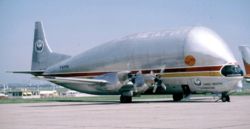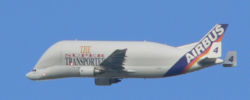PlaneSpottingWorld welcomes all new members! Please gives your ideas at the Terminal.
Airbus Beluga
| Airbus A300-600ST Beluga | |
|---|---|
| Beluga in current colours | |
| Type | Outsize cargo freight aircraft |
| Manufacturer | EADS (Airbus S.A.S.) |
| Maiden flight | 13 September 1994 |
| Introduced | September 1995 |
| Status | In service |
| Primary user | Airbus Transport International |
| Number built | 5 |
| Unit cost | N/A |
| Developed from | Airbus A300-600 |
The Airbus A300-600ST (Super Transporter) or Beluga is a version of the standard Airbus A300 wide-body airliner, modified to carry aircraft parts and over-sized or awkward cargo. It was officially called the Super Transporter at first, but the name Beluga became popular and has now been adopted as official.
History
Several major aircraft manufacturers are multinational, and it is not unusual for them to have plants in widely separated locations. Airbus, however, is unique in that it was a consortium formed by the major French, British, German, and Spanish aerospace companies, and the geographic location of Airbus manufacturing is not merely a matter of cost and convenience, it is also a matter of history, national interest and pride. In consequence, each of the Airbus partners makes an entire aircraft section, which needs to be transported to a central location for final assembly. The details vary from one model to another, but the general arrangement is for the wings to be made in Britain, the tail in Spain, the fuselage in Germany, and the nose and centre-section in France; all being united at either Toulouse or Hamburg.

When Airbus started in 1970, the first few components were delivered by road, but growing production numbers soon necessitated a switch to air transport. From 1972 onwards a fleet of four highly modified "Super Guppys" took over. These were former Boeing Stratocruisers from the 1940s, converted with custom fuselages and turbine engines to carry large volume loads for the 1960s NASA space program, leading to the jibe that 'every Airbus is delivered on the wings of a Boeing'. As time went by, the Super Guppys became unsatisfactory: their age meant that operating expenses were high and growing higher, and increasing Airbus production rates needed greater capacity.
In 1991 Aérospatiale and DASA, two of the major Airbus partners, formed a company to develop a replacement. The starting point was the design for the wide-body twin-engined Airbus A300: the wings, engines, landing gear, and the lower part of the fuselage are the same as the A300 while the upper part of the fuselage is an enormous horseshoe-shaped structure 7.7 metres in diameter. To provide access to the cargo area from the front without having to disconnect all electrical, hydraulic and flight control connections (not to mention the lengthy recalibrations before each flight the reconnection entailed), the standard A300 cockpit was moved down below the cargo floor level and a 17 metre high cargo door fitted. Finally, the tail structure was enlarged and strengthened to maintain directional stability.
Construction began in September 1992, the first flight was in September 1994. After 335 hours of test flying, certification was awarded in September 1995 and the A300-600ST, now known as the Beluga, entered service. Four more Belugas were constructed, at a rate of roughly one a year, and all five remain in regular service. Their primary task is to carry Airbus components across Europe ready for final assembly in Toulouse or Hamburg, but they are available for charter work as well, and have been used to carry a variety of special loads, including space station components, large, very delicate artworks, industrial machinery, and entire helicopters. (The Beluga illustrated above had been chartered to carry two complete NHI NH90s and a Eurocopter Tiger from Europe to Australia and back). The A300-600ST's freight compartment is 7.4 metres in diameter and 37.7 metres long; maximum payload is 47 tons. At 153.9 tonnes its maximum take-off weight is comparable to a normal A300 showing that this plane was intended for large but relatively light cargo.
Technical data
| Measurement | A300-600ST |
|---|---|
| Length | 56.16 m (184ft) |
| Span | 44.84 m (147ft) |
| Height | 17.34 m (57ft) |
| Wing area | 258.8 m² (849ft2) |
| Fuselage diameter | 7.7 m (25 ft) |
| Weight empty | 86.0 t |
| Maximum take-off weight | 153.9 t |
| Range (at 40 tons) | 2,780 km (1727 Statute Miles) |
| Range (at 26 tons) | 4,630 km (2877 |
| Cargo capacity | 47 tons |
| Cargo volume | 1,365 m³ (848 Ft3) |
| Cockpit Crew | Four |
External links
Related content
Related development
Comparable aircraft
See also
Airbus aircraft | ||
|---|---|---|
| Civil | A300 · A300 Beluga · A310 · A320 family (A318, A319, A320, A321) · A330 · A340 · A350 · A380 |  |
| Military | A310 MRTT · A330 MRTT · A400M | |
| In development/ proposed | A350 · A400M · NSR · KC-45 | |
| Other supported types | Sud Aviation Caravelle · Aérospatiale-BAC Concorde | |
| See also | A380 production list · Airbus A380 videos | |
Lists relating to aviation | |
|---|---|
| General | Timeline of aviation · Aircraft · Aircraft manufacturers · Aircraft engines · Aircraft engine manufacturers · Airports · Airlines |
| Military | Air forces · Aircraft weapons · Missiles · Unmanned aerial vehicles (UAVs) · Experimental aircraft |
| Notable incidents and accidents | Military aviation · Airliners · General aviation · Famous aviation-related deaths |
| Records | Flight airspeed record · Flight distance record · Flight altitude record · Flight endurance record · Most produced aircraft |
ar:ايرباص بولقا cs:Airbus Beluga de:Airbus Beluga es:Airbus Beluga eu:Airbus Beluga fr:Airbus A300-600ST gl:Airbus Beluga it:Airbus A300-600ST Beluga nl:Airbus A300-600ST Beluga ja:エアバスベルーガ pl:Airbus Beluga pt:Airbus Beluga ru:Airbus Beluga sr:Ербас Белуга uk:Аеробус 300-600ST zh:SATIC A300-600ST




